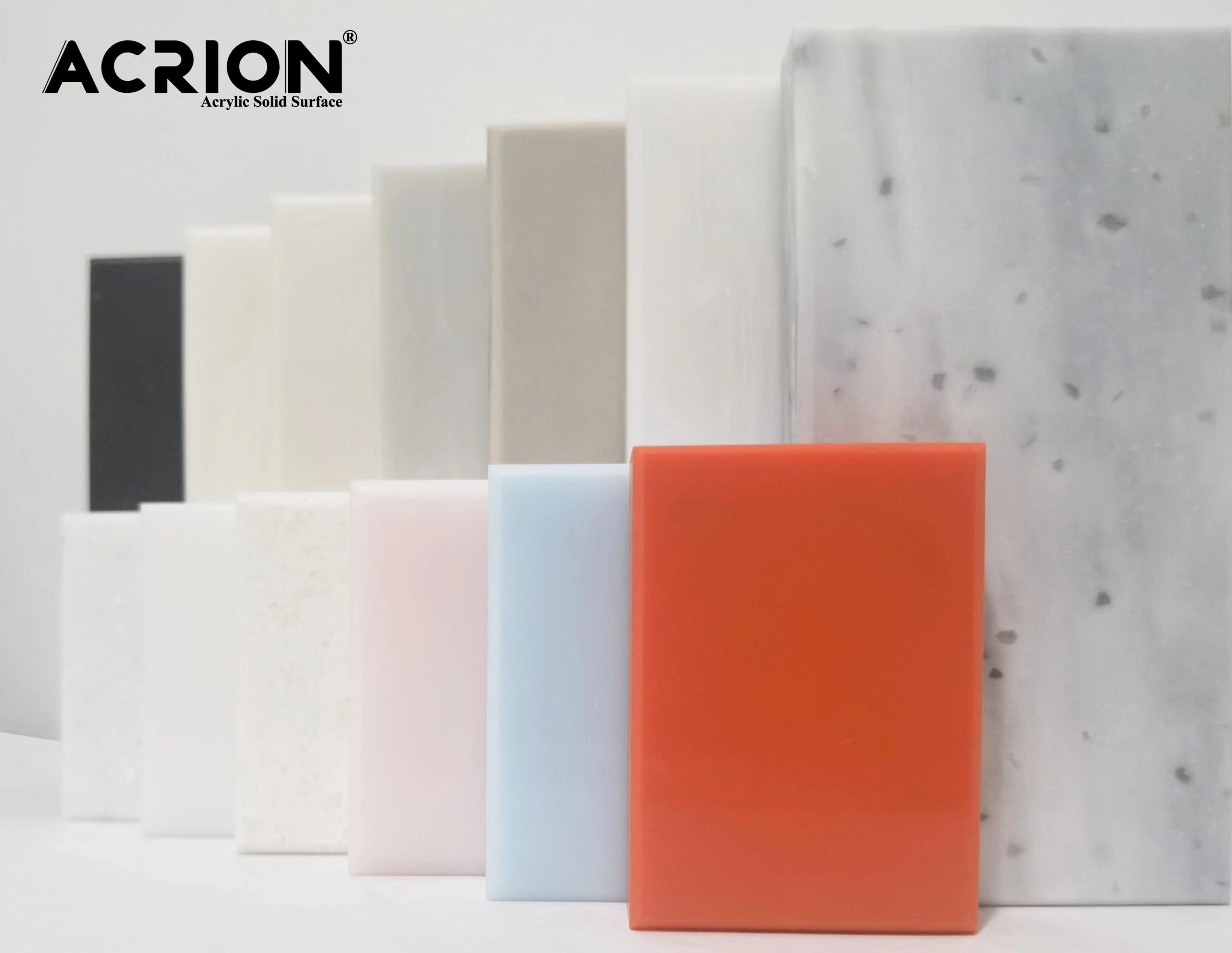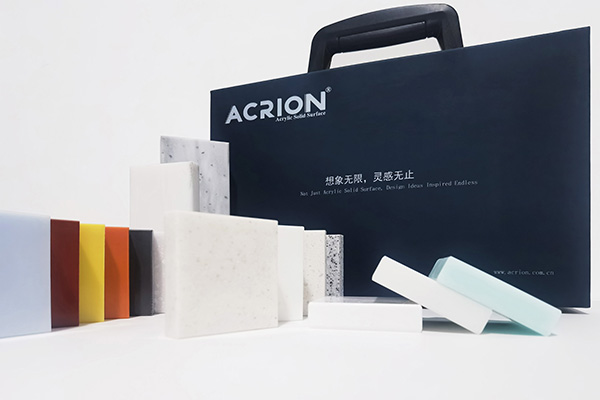Analyse der antibakteriellen und antimykotischen Eigenschaften auf der Oberfläche von Acrylfeststoffen
Die antibakterielle und antimykotische Wirkung von Acryl-Feststoffoberflächen wird durch die Harzmodifikationstechnologie, die Art der Zusatzstoffe und die Umgebungsbedingungen beeinflusst. Die folgende Analyse wird unter drei Aspekten durchgeführt: antibakterieller Mechanismus, antimykotische Leistung und Einflussfaktoren:
Erstens die Quellen und Mechanismen antibakterieller Eigenschaften
Doping mit antibakteriellen Wirkstoffen
Antibakterielle Funktionen können der Beschichtung verliehen werden, indem anorganische antibakterielle Wirkstoffe (z. B. Zinkoxid, Silberionen) oder organische antibakterielle Wirkstoffe (z. B. quartäre Ammoniumsalze) in Acrylharz eingebracht werden. Beispielsweise kann Zinkoxid unter Bestrahlung mit ultraviolettem Licht eine photokatalytische Aktivität erzeugen, indem es Zinkionen freisetzt, um die Zellmembranen von Bakterien zu zerstören und so die Bakterienvermehrung zu hemmen. Experimente zeigen, dass die Zinkoxid enthaltende Acrylbeschichtung nach der Simulation des täglichen Tragens immer noch eine hohe antibakterielle Aktivität aufrechterhalten kann. Die Freisetzung von Zinkionen steigt nach der Verschleißbehandlung deutlich an und die photokatalytische antibakterielle Wirkung ist hervorragend.
Oberflächenmodifikationstechnologie
Antibakterielle Gruppen werden durch chemische Transplantation oder physikalische Mischung auf die Oberfläche von Acrylharz eingeführt. Beispielsweise kann die Mischung von Siloxan-haltigen antibakteriellen Wirkstoffen mit Acrylharzen die Beschichtungsoberfläche mit Hydrophobizität und antibakteriellen Eigenschaften ausgeben, wodurch die bakterielle Adhäsion verringert wird. Darüber hinaus kann die Einführung von Nano-Antibakterienmeistern (wie Nano-Silber) die antibakterielle Leistung weiter verbessern, aber ihre Dispergierbarkeit muss kontrolliert werden, um eine Agglomeration zu vermeiden.
Umweltverträgliche antibakterielle
Einige Acrylbeschichtungen können antibakterielle Mechanismen durch Umweltreize wie Feuchtigkeit und Licht auslösen. Zum Beispiel beschleunigt die Freisetzungsrate des antibakteriellen Mittel in einer feuchten Umgebung die Freisetzungsrate des antibakteriellen Wirkstoffs, wodurch die antibakterielle Wirkung verbessert wird. Dieses Merkmal eignet sich für die antibakteriellen Anforderungen in Umgebungen mit hoher Luftfeuchtigkeit wie Badezimmern und Küchen.
Zweitens die Leistung und die Einflussfaktoren der Anti-Art-Leistung
Anti-Form-Mechanismus
Die Anti-Form-Leistung der Acrylbeschichtung hängt hauptsächlich von ihrer dichten Oberflächenstruktur und niedrigen Wasserabsorptionsrate ab. Durch die Optimierung der Harzformel und des Aushärtungsprozesses kann die Porosität der Beschichtungsoberfläche verringert werden, wodurch die Haftung und das Wachstum von Schimmelpilzsporen hemmt. Darüber hinaus kann das Hinzufügen von Fungiziden (z. B. Isothiazolinonen) den Anti-Form-Effekt weiter verbessern, aber der Kompatibilität mit dem Harz sollte die Aufmerksamkeit geschenkt werden.
Der Einfluss von Umweltbedingungen
Das Wachstum von Schimmel erfordert die Zufriedenheit von drei Elementen: Feuchtigkeit, Temperatur und Nährstoffsubstrat. Zum Beispiel beschleunigt sich in einer Umgebung mit einer Temperatur zwischen 25 und 30 ° und einer Luftfeuchtigkeit von ≥ 80%signifikant. Die Acrylbeschichtung sollte eine gute Wasserbeständigkeit und Atmungsaktivität aufweisen, um zu verhindern, dass die Ansammlung von Wasser auf der Oberfläche ein Schimmelwachstum verursacht. Darüber hinaus beeinflusst der pH-Wert der Beschichtungsoberfläche auch die Anti-Form-Leistung. Eine neutrale oder schwach alkalische Umgebung ist förderlicher, um das Schimmelwachstum zu hemmen.
Langfristige Haltbarkeit
Die Antischimmelwirkung einer Acrylbeschichtung kann mit der Zeit nachlassen. Beispielsweise können ultraviolette Strahlung und Regenerosion in Außenumgebungen dazu führen, dass die Beschichtungsoberfläche altert und das Anti-Schimmel-Mittel verloren geht, wodurch die Anti-Schimmel-Wirkung verringert wird. Daher muss die Lebensdauer der Beschichtung durch den Zusatz von Lichtschutzmitteln und witterungsbeständigen Harzen verlängert werden.
Drittens, die Schlüsselfaktoren, die die antibakterielle und antimykotische Wirkung beeinflussen
Arten und Dosierungen antibakterieller Wirkstoffe
Die antibakterielle Wirkung anorganischer antibakterieller Mittel (wie Zinkoxid und Silberionen) ist langlebig, kann jedoch die Transparenz und die mechanischen Eigenschaften der Beschichtung beeinflussen. Organische antibakterielle Mittel (z. B. quaternäre Ammoniumsalze) haben eine schnelle antibakterielle Geschwindigkeit, aber ihre Wärmeresistenz und Haltbarkeit sind relativ schlecht. Zum Beispiel kann der übermäßige Inhalt des Silberionen zu einer Verfärbung führen, und die Additionsmenge an Zinkoxid muss bei 5-10% kontrolliert werden, um die antibakterielle Leistung und die Beschichtungsleistung auszugleichen.
Eigenschaften der Harzmatrix
Die Glasübergangstemperatur (Tg) und die Vernetzungsdichte von Acrylharz beeinflussen die Freisetzungsrate antibakterieller Wirkstoffe. Beispielsweise kann Harz mit hohem Tg die Freisetzung antibakterieller Wirkstoffe verlangsamen und die antibakterielle Wirkung verlängern; Eine mäßige Vernetzung kann die Dichte der Beschichtung erhöhen und die Schimmelbildung verringern. Darüber hinaus ist die Antischimmelwirkung umso besser, je stärker die Hydrophobie des Harzes ist.
Konstruktions- und Aushärtungsbedingungen
Die Temperatur und Luftfeuchtigkeit der Bauumgebung beeinflussen die Aushärtungswirkung sowie die antibakterielle und antimykotische Wirkung der Beschichtung. Beispielsweise kann die Aushärtung bei niedrigen Temperaturen oder hoher Luftfeuchtigkeit zu ungleichmäßigen inneren Spannungen in der Beschichtung führen und so deren Haltbarkeit verringern. Darüber hinaus beeinflussen auch die Aushärtungszeit und die Lichtintensität die Vernetzungs- und Fixierungswirkung des antibakteriellen Mittels.
Viertens Anwendungsszenarien der antibakteriellen und antimykotischen Leistung
Medizinische Einrichtungen
Die Anforderungen an die antibakterielle Leistung von Beschichtungen in Krankenstationen, Operationssälen und anderen Bereichen sind äußerst hoch. Beispielsweise können antibakterielle Acrylbeschichtungen auf Wände und Möbeloberflächen aufgetragen werden, um das Risiko einer Bakterienübertragung zu verringern. Solche Beschichtungen müssen über hochwirksame antibakterielle Eigenschaften (z. B. eine Hemmrate von ≥99 % gegen Escherichia coli und Staphylococcus aureus) und eine lange Haltbarkeit verfügen.
Lebensmittelverarbeitungsanlage
Schimmelpilzbefall in der Lebensmittelverarbeitungsumgebung muss streng kontrolliert werden. Beispielsweise kann eine Acryl-Anti-Schimmel-Beschichtung auf Werkstattwände und Geräteoberflächen aufgetragen werden, um Schimmelbildung und Lebensmittelverunreinigungen vorzubeugen. Um die Anforderungen an die Lebensmittelsicherheit zu erfüllen, müssen solche Beschichtungen eine chemische Beständigkeit (z. B. Beständigkeit gegen Säuren, Laugen und Reinigungsmittel) und niedrige VOC-Emissionen aufweisen.
Öffentliche Gebäude
Die Wände und Böden öffentlicher Orte wie Schulen und Einkaufszentren sind anfällig für mikrobielle Kontamination. Beispielsweise können antibakterielle und schimmelhemmende Acrylbeschichtungen auf häufig berührte Bereiche wie Badezimmer und Aufzugsknöpfe aufgetragen werden, wodurch das Risiko einer Kreuzinfektion verringert wird. Damit die antibakterielle Wirkung langfristig erhalten bleibt, müssen solche Beschichtungen verschleißfest und leicht zu reinigen sein.
Fünftens Strategien zur Verbesserung der antibakteriellen und antimykotischen Leistung
Zusammengesetztes antibakterielles System
Durch die Verbindung anorganischer antibakterieller Wirkstoffe mit organischen antibakteriellen Wirkstoffen kann eine antibakterielle Breitbandwirkung erzielt werden. Beispielsweise kann die synergistische Wirkung der antibakteriellen Wirkstoffe Zinkoxid und quartäres Ammoniumsalz gleichzeitig das Wachstum von Bakterien und Schimmelpilzen hemmen. Darüber hinaus kann der Zusatz von Photokatalysatoren (z. B. Titandioxid) die photokatalytische antibakterielle Leistung der Beschichtung verbessern.
Kontrolle der Oberflächenmikrostruktur
Durch die Regulierung der mikroskopischen Morphologie der Beschichtungsoberfläche (wie Rauheit und Porosität) kann die Adhäsion von Mikroorganismen verringert werden. Beispielsweise kann die Anwendung der superhydrophoben Oberflächentechnologie den Kontaktwinkel der Beschichtungsoberfläche von ≥150 ° machen, wodurch die Adhäsion von Schimmelpilzsporen hemmt. Darüber hinaus kann das Konstruktion von Oberflächenmuster auch den Kontaktbereich für Mikroorganismen verringern.
Langlebige Anti-Art-Technologie
Die Wirkungszeit von Fungiziden wird durch die Slow-Release-Technologie verlängert. Beispielsweise können Fungizide in Mikrokapseln verkapselt werden, so dass sie beim Auftragen der Beschichtung nach und nach freigesetzt werden und so eine langfristige fungizide Wirkung erhalten bleibt. Darüber hinaus kann die Zugabe von selbstheilenden Materialien dazu führen, dass sich die Beschichtung nach einer Beschädigung automatisch selbst repariert und ihre Anti-Schimmel-Eigenschaften wiederherstellt.



